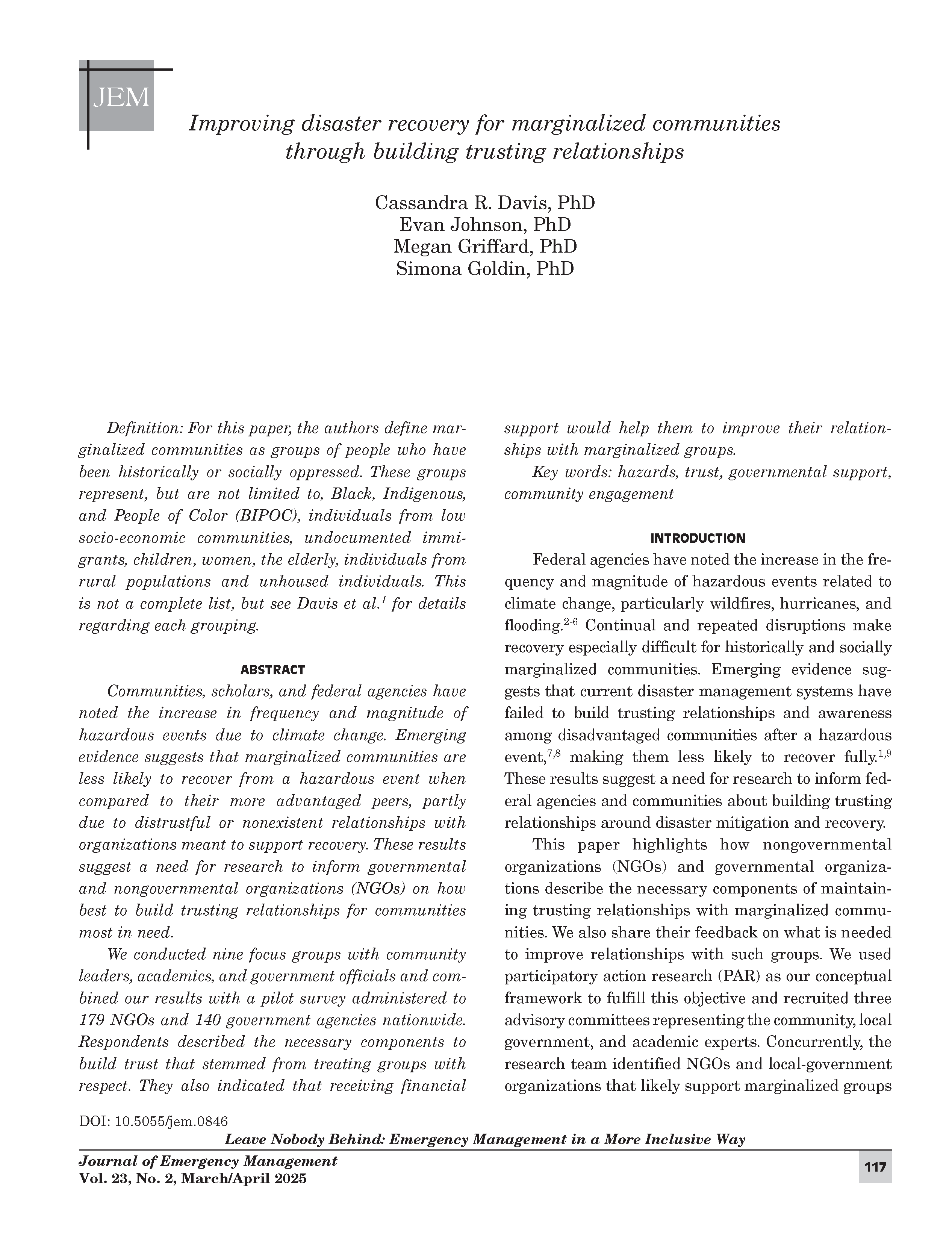Improving disaster recovery for marginalized communities through building trusting relationships
DOI:
https://doi.org/10.5055/jem.0846Keywords:
hazards, trust, governmental support, community engagementAbstract
Communities, scholars, and federal agencies have noted the increase in frequency and magnitude of hazardous events due to climate change. Emerging evidence suggests that marginalized communities are less likely to recover from a hazardous event when compared to their more advantaged peers, partly due to distrustful or nonexistent relationships with organizations meant to support recovery. These results suggest a need for research to inform governmental and nongovernmental organizations (NGOs) on how best to build trusting relationships for communities most in need.
We conducted nine focus groups with community leaders, academics, and government officials and combined our results with a pilot survey administered to 179 NGOs and 140 government agencies nationwide. Respondents described the necessary components to build trust that stemmed from treating groups with respect. They also indicated that receiving financial support would help them to improve their relationships with marginalized groups.
References
Davis CR, Berke P, Holloman D, et al.: Supporting Strategies for Socially Marginalized Neighborhoods Likely Impacted by Natural Hazards. Chapel Hill: Coastal Resilience Center, 2021.
FEMA: Climate change. 2021. Available at https://www.fema.gov/emergency-managers/national-preparedness/climate-change.
US Homeland Security [DHS]: Climate change adaption roadmap. 2012. Available at https://www.dhs.gov/sites/default/files/publications/Appendixpercent20Apercent20DHSpercent20FY2012percent20Climatepercent20Changepercent20Adaptationpercent20Plan_0pdf. Accessed December 11, 2022.
NASA: Climate change: How do we know? 2021. Available at https://climate.nasa.gov/evidence/.
National Oceanic and Atmospheric Administration [NOAA]: Climate change. 2021. Available at https://www.noaa.gov/categories/climate-change. Accessed December 11, 2022.
US Environmental Protection Agency [EPA]: Climate change indicators: Weather and climate. 2021. Available at https://www.epa.gov/climate-indicators/weather-climate.
Berke P, Cooper J, Salvesen D, et al.: Building capacity for disaster resiliency in six disadvantaged communities. Sustainability. 2010; 3(1): 1-20. DOI: 10.3390/su3010001.
Findholt NE: The culture of rural communities: An examination of rural nursing concepts at the community level. In Winters CA (ed.): Rural Nursing: Concepts, Theory, and Practice. 4th ed. New York: Springer Publishing Company, 2013.
Beaver M, Zebrowski E, Howard JA: Category 5: The Story of Camille, Lessons Unlearned from America’s Most Violent Hurricane. Ann Arbor, MI: University of Michigan Press, 2005.
Winther R, Marsh W: Hazards, accidents and events—A land of confusing terms. In Safety, Reliability and Risk Analysis: Beyond the Horizon. Boca Raton, FL: CRC Press, 2013: 2545-2553.
Kemmis S, McTaggart R, Nixon R: The Action Research Planner: Doing Critical Participatory Action Research. Singapore: Springer Science & Business Media, 2013. Accessed February 18, 2021.
Browne K: Who lives here: How understanding culture reduces suffering, speeds recovery, and supports resilience. Research Counts. 2017. Available at https://hazards.colorado.edu/news/research-counts/who-lives-here-how-understanding-culturereduces-suffering-speeds-recovery-and-supports-resilience. Accessed June 15, 2022.
Kelman I, Lewis J, Gaillard JC, et al.: Participatory action research for dealing with disasters on islands. Island Stud J. 2011; 6(1): 59-86.
Trajber R, Walker C, Marchezini V, et al.: Promoting climate change transformation with young people in Brazil: Participatory action research through a looping approach. Action Res. 2019; 17(1): 87-107. Accessed February 18, 2021.
McCall MK, Peters-Guarin G: Participatory action research and disaster risk. In The Routledge Handbook of Hazards and Disaster Risk Reduction. Oxford, UK: Routledge, 2012. Accessed February 18, 2021.
Wang CC: Photovoice: A participatory action research strategy applied to women’s health. J Women’s Health. 1999; 8(2): 185-192.
Meyer MA, Hendricks M, Newman GD, et al.: Participatory action research: Tools for disaster resilience education. Int J Disaster Resil Built Environ. 2018; 9: 402-419.

Published
How to Cite
Issue
Section
License
Copyright 2007-2025, Weston Medical Publishing, LLC and Journal of Emergency Management. All Rights Reserved.





